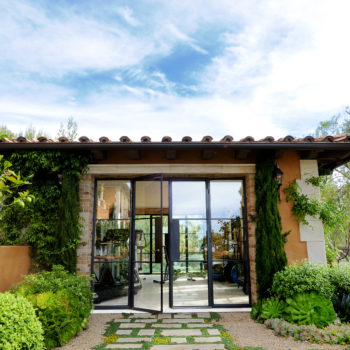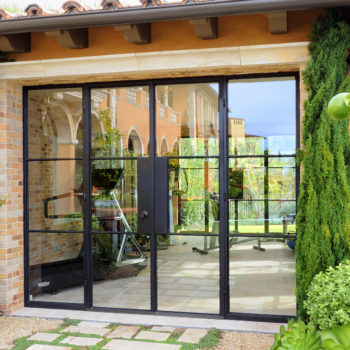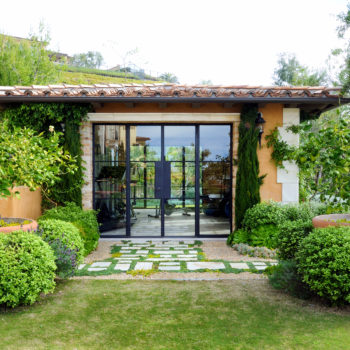Check out homes where the doors to the bedroom, bathroom, and kitchen are likely all swing doors. A swing door is any entrance with two hinges that open either inwards or outwards.
They are always framed, but they can be constructed from various materials, including wood, aluminum, plastic, steel, and glass, allowing you to customize the door to fit your client’s space.
Most swing doors are manually operated, but selecting an automated swinging door offers many additional benefits.
Automated Swing Doors
Automated swing doors are appropriate for both interior and exterior applications. They can be created with or without a threshold and can fulfill a variety of needs. With break-out features, smoke and fire control features, and burglary protection for added security, they make great emergency doors.
If your client has specific requirements, you can add various features like soundproofing.
The Benefits of Automatic Doors
When you opt for an automated swing door over a manual swing door, you improve the accessibility of a building, increase hygiene standards, and ensure passage without obstructions. And with regulated closing sequences and locking security, you can rest assured they also contribute to the safety and security of the building.
Double Swinging Doors
A double-swinging door is a single or double door that can swing in two directions. It is also known as a double-action door.
When the two doors are attached to their hinges, each can swing independently and in both directions. Double-swinging doors are instantly recognizable from wild-west films, but they’ve undergone significant development since then.
These doors are a cost-effective solution to the problem of two-way movement through any opening, allowing both spaces to retain some degree of privacy. Additionally, the doors create a visual or sound barrier between the two areas.
Although solutions are essential, you do not need to spend an arm and a leg on providing them. Ensure that you purchase a door that fits your client’s space.
Double-Action Hinges or a Pivot Hinge
Double swinging doors, unlike single swinging doors, are mounted on double-action hinges or pivot hinges. This allows the door to swing in both directions and automatically return to its center position.
Double action hinges, unlike single action hinges, do not require door stops or a traditional door jamb. Simple and quick installation of double action hinges is possible. Double swinging doors can be installed in both traditional and non-traditional openings.
There are a variety of double-action hinge options for swinging doors. Choose the hold open or non-hold open feature when selecting your hardware, depending on your client’s preference.
With the versatility of a double-action hinge, swinging doors can be installed in various locations throughout the residence. They can be installed in tight spaces and virtually any opening size.
Why Choose Swinging Doors?
Double swinging doors are a simple solution to any door problems that may arise.
In certain instances, you may require a door that provides privacy and functionality. Standard doors impede the transmission of air conditioning and heat between spaces. This is a common issue that full-sized doors struggle to resolve.
Frequently, a double-swinging door is only partially long. This indicates that airflow can pass freely underneath and over the door. These are available in various lengths and widths, which means that you won’t need to modify the opening and can purchase a door that fits.
These doors will also remain permanently closed because the mechanism will return the doors to their center position, ensuring that you will never forget to close them again.
Swing Door vs Sliding Door vs French Door
Choosing a door style is likely one of the most sought-after home improvement projects. Whether you’re building a new home from the ground up or simply remodeling, selecting the right door will add roughly the same amount of value to your client’s home as it will cost to purchase and install. Understanding how each type operates and where it will function most effectively will help you select the ideal door.
Let’s look at swing doors, sliding doors, and French doors to determine which style is best for your client’s residence.
- Swing Doors – Single-panel and double-panel swing doors are ideal for larger openings and dramatically improve natural daylighting. With a left and right hinge, they provide both out-swing and in-swing options, making them suitable for both residential and commercial use.
Swing doors, one of the most advanced doors available, are also available in manual and automatic variations.
- Sliding Doors – Sliding doors are an ideal way to extend the ambiance of your client’s home by blending seamlessly with the great outdoors.
These doors, also known as bypass doors, visually enlarge and brighten any room while providing unobstructed views of both the interior and exterior.
- French Doors – French doors add an understated elegance to any room, they adorn and complement almost any layout design. They effortlessly make a dramatic statement and will captivate you and your clients for many years.
The real answer depends on your client’s specific requirements. The choice between an all-purpose sliding door, an extravagant French door, and a multipurpose, highly secure swing door is ultimately determined by the individual’s needs, architectural configuration, and budget.
Whatever door you select for your client, be sure to customize it to their preferences and a swing door made from steel can definitely add value and enhance curb appeal for your client’s property.
Visit our website to check out the products we’ve done in the past or to speak with a steel swing door expert, contact us at 877-590-2741 at Euroline Steel Windows and Doors today!

![User Name: [Duncan], Real Name: , Location: Nottingham, UK, License: AttributionCC window cleaner](https://farm9.staticflickr.com/8527/8508092704_bffa2893b1.jpg)



